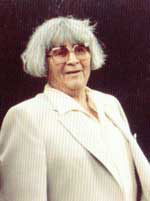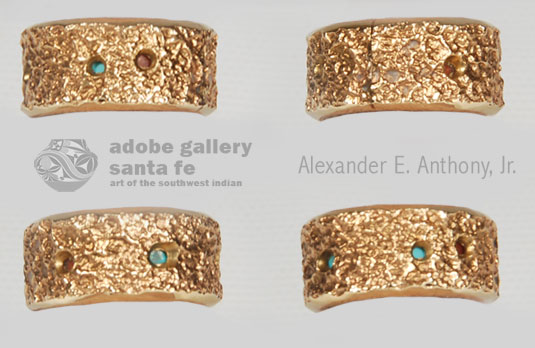Tufa-Cast Gold Ring with Hopi Inlay Interior by Charles Loloma [SOLD]
+ Add to my watchlist Forward to Friend
- Category: Jewelry Rings
- Origin: Hopi Pueblo, Hopituh Shi-nu-mu
- Medium: Gold, turquoise, coral, lapis lazuli
- Size: 5-1/4; 3/8” wide
- Item # C4040 SOLD
 Hopi Indian jeweler, painter and potter, Charles Loloma (1921-1991), was one of the most famous and influential Native artists of the 20th century. His mother was a basket maker and his father a weaver, and so he was exposed to Hopi Indian artistic traditions at a young age. His elementary school teachers took notice of the natural skill with which he drew and painted. Later, while attending the Hopi Indian School, he was presented with greater opportunities by Hopi painter Fred Kabotie, who ran the school’s successful and well-equipped art program.
Hopi Indian jeweler, painter and potter, Charles Loloma (1921-1991), was one of the most famous and influential Native artists of the 20th century. His mother was a basket maker and his father a weaver, and so he was exposed to Hopi Indian artistic traditions at a young age. His elementary school teachers took notice of the natural skill with which he drew and painted. Later, while attending the Hopi Indian School, he was presented with greater opportunities by Hopi painter Fred Kabotie, who ran the school’s successful and well-equipped art program.
Under the tutelage of Kabotie, Loloma studied painting, printmaking, leatherwork and weaving. After transferring to the Phoenix Indian High School for his junior and senior years, he was presented with even greater opportunities. He was invited to travel to San Francisco and then New York to participate in major exhibitions of Native art. Loloma, who came from humble beginnings, was excited by these early successes and continued painting after high school. Martha Hopkins Struever’s Loloma sums up how the artist’s early experiences as a painter contributed to his later success as a jeweler: “(his) teenage experiences helped him develop a sensitivity to the use of color that later expressed itself in his choice and arrangement of stones in jewelry.”
Loloma married Otellie Pasivaya in 1941 and was inducted into the U.S. Army in 1942. His artistic sensibilities and aforementioned “sensitivity to...color” most likely led him to his initial military role: camouflage instructor. Later, he was involved in construction, supervising and instructing workers during the creation of roads and bridges. Sergeant Loloma was honorably discharged in 1946, and promptly returned to his calling: creating artwork steeped in Hopi tradition. He and Otellie tackled pottery making, spending two years studying ceramics at the School for American Craftsmen in New York. After completing their studies, they returned to the Hopi reservation.
Loloma’s pottery was unlike that of his traditionalist neighbors, who did not approve of his decidedly modern and experimental efforts. It was, however, desirable to collectors. He enjoyed several successful exhibitions of his works in clay. He eventually left the Hopi reservation in favor of Tucson, where he was presented with greater opportunities for success and creative freedom. He continued making pottery but began to expend more time and energy on the creation of jewelry, which would become his true passion.
Loloma was a gifted and wildly creative jeweler with a voracious appetite for knowledge and experimentation. He studied and experimented with a variety of forms and techniques, beginning with Tufa casting and Hopi overlay before developing and mastering the colorful multi-stone Inlay style for which he is best known today. His success as a jeweler made his previous endeavors appear quite modest. He traveled the world, exhibited in Paris, taught at the Institute of American Indian Art, and was featured in print and on television alongside the era’s other groundbreaking Native artists. Loloma passed away in 1991, after a long and successful career making works in a variety of media. Today, he is regarded as one of the best and most influential jewelers of the twentieth century. His works continue to increase in value, visibility, and collectibility.
This gold ring illustrates why Loloma’s work has become even more desirable with the passage of time. It is timeless, beautiful, and can be worn by people of either gender. Within a striking gold ring, the artist set a series of small coral, turquoise and lapis stones. These colorful stones, exposed inside the ring, are fully visible only when the ring is not being worn. Loloma used this technique often, calling the hidden stones “inner gems.” His intention was to reflect the inner beauty that is within all humans—that which is invisible from the outside. With this piece, his “inner gems” are partially visible from the outside through a series of six small holes in the ring’s textured exterior, which is a result of the tufa casting process. This is a subtle, excellently crafted design from one of the greatest and most collectible Native artists.
Condition: this Tufa-Cast Gold Ring with Hopi Inlay Interior by Charles Loloma is in excellent condition
Provenance: from the collection of a resident of Michigan
Reference and Recommended Reading: Loloma by Martha Hopkins Struever, 2005

- Category: Jewelry Rings
- Origin: Hopi Pueblo, Hopituh Shi-nu-mu
- Medium: Gold, turquoise, coral, lapis lazuli
- Size: 5-1/4; 3/8” wide
- Item # C4040 SOLD



